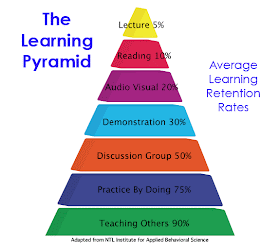 | |
| Indiana Jones teaching |
 |
| Ip Man and his student Bruce Lee |
Class Size
Class size may play the biggest role in how you teach. If you are in front of a class with only a couple of students, then the interaction will be more personal. You will be able to deal with the individual's needs. What does Bob need to work on to become a better at Kung Fu? Maybe he's quicker at learning forms, but needs a longer time with learning and seeing applications. Mary may be better at applying the form, but needs to work on her conditioning. With small class size, you can split your time between both of these extremes. In larger classes, there are too many people to fully gain individual instruction. A good teacher will tend to teach to the middle ground in this situation. They will work with ideas and concepts that everyone needs practice with.
Different Learning Styles
Everyone learns differently. There are three basic forms of learning modalities: Visual, Auditory, and Tactile (Kinesthetic). Everyone has a smattering of each of them, but generally leans towards one or the other. Visual learners, learn by seeing something, shapes, pictures, etc. They will often benefit from seeing things at different angles. They will use visual clues to learn something. Auditory uses sound, including explanation of techniques. Kinesthetic learners, learn through feel and touch. They often like to have the techniques done to them. Personally I know I'm a very visual learner (hence the drawings in my journal), but I also need to feel a technique before I can understand it. Be aware of the different learning models when teaching, and try to include all aspects of learning. Some students may respond to one method over another.
Modeling
Modeling is a method of teaching by demonstrating. This is the most common method of instruction in martial arts. The instructor demonstrates a technique, or principle, and then the student follows their example. The amount of explanation depends mainly on the system. From what I've heard, in the old school Japanese systems, the instructor would demonstrate the technique a couple of times, and without any explanation, tell the students to go practice. When the students got the techniques I believe they were able to internalize them a lot more than we do today. I think our western brains require us to intellectualize something before we can do it. We have to have explanations. If you teach, try it both ways, and find your own happy balance between explanation and intuitively learning the technique.
 |
| Teaching means you learn more. |
Teach what you know
One of the biggest pitfalls of instruction is ego. It is OK to not know everything. One of the weirdest situations I've ever encountered was a fellow high school science teacher. When he didn't know an answer, he was so scared of looking foolish or ignorant in front of students that he'd make answers up. Many times he was dead wrong with his answers. When a student would try to, politely mind you, call his answer wrong, he'd have to back-peddle, and flub his response, which made him look more foolish. It is much wiser to say "You know I'm not sure, let's find out." Students will have more respect if you don't know an answer, but can point them in the direction to find it.
As part of this idea, don't go beyond yourself. Don't try to instruct a subject you don't understand, that you haven't internallized. You can teach a form, but unless your sure of yourself, don't try to reach beyond your understanding and teach the applications of the form, your students will know. Remember they have a lot of practice being students.
There are lots of other hints that people can give to newly minted instructors. There are whole fields of psychology dedicated to the methods of how the human brain learns. These are just a few pointers. Because I've met many great martial artists, who cannot teach what they know effectively and that means their information is trapped. It cannot reproduce itself in the next generation. And that is a real problem for their art.

As a student of the martial arts for many years, I have experienced many different teaching styles. The three most common instructors, were the instructors who would teach me why THEY were the BEST. Then there were the instructors who would attempt to teach me to BE as good as THEY were. And every once in a great while, there was an instructors who would simply teach me how to BE my personal best. I am not implying that ether of these teaching styles is better than the other, but if given a choice, I would choose that latter.
ReplyDelete